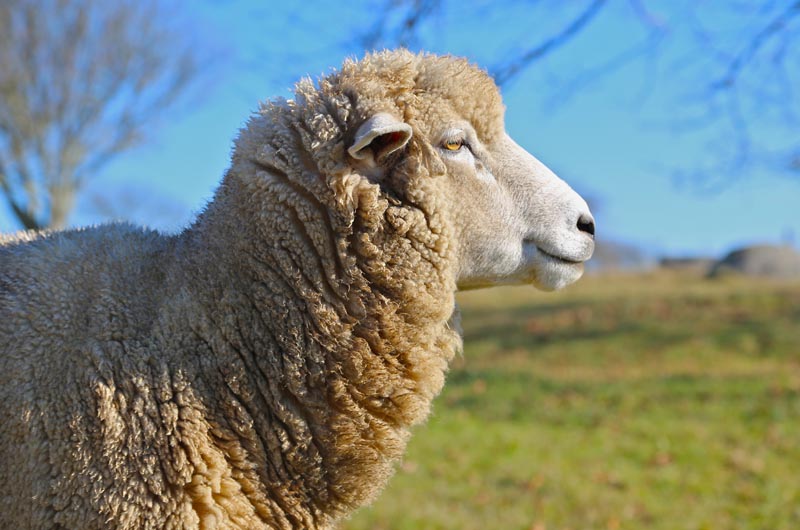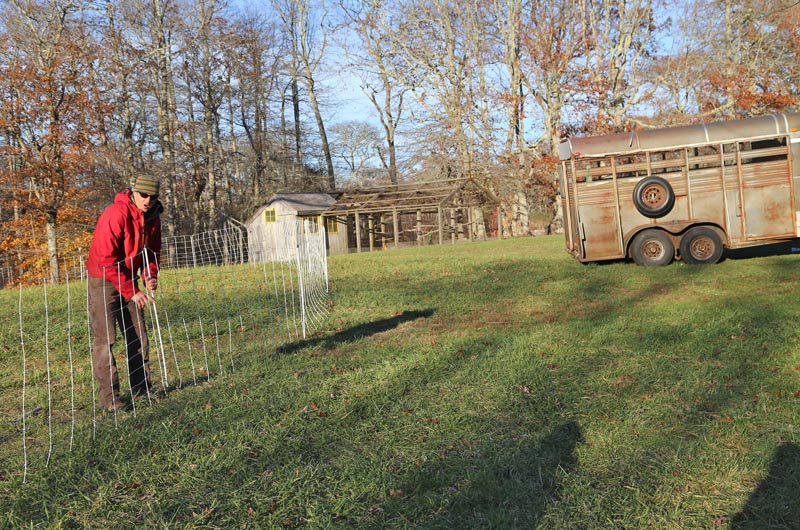The story of sheep on Martha’s Vineyard doesn’t begin with 40 British ships sailing into the Vineyard Haven harbor, but it certainly was a turning point.
In September of 1778, Major General Sir Charles Grey of the British army arrived on Martha’s Vineyard to round up supplies for his troops who were stationed in Newport, R.I. During Grey’s Raid the Vineyarders were forced at swordpoint to surrender food and weapons and town funds.
According to a 1939 article in the Vineyard Gazette entitled Sheep on the Vineyard, Island residents were also forced to give up 10,574 sheep.
The Islanders tried to resist, especially when it came to their livestock. In the same article it said, “Arms were hidden, buried in the woods, and cows and pigs were tied up there, too . . . There’s an old tale of a girl who locked herself and her prize cow in the attic to avoid capture.”
Nathaniel (Ned) Allen-Posin of Allen Farm in Chilmark said that the story told in his family is that when the British came the Allens hid three healthy sheep in a space behind the fireplace. The idea was to have animals to breed when they lost their flock.
Today the Allen Farm hosts 32 lambs and 45 ewes. These sheep are not biological descendants of the three who escaped the British but they have inherited the same pasture and the same sweeping ocean view.
On a sunny November afternoon, newlyweds Ned and Kaila Allen-Posin walked from the farm store at the entrance to their property to one of their pastures. Along the way they stopped to talk with a new ram, a Dorset breed who will mate with the current Corriedale flock this winter. It’s the first time in many years that the Allen Farm has crossbred their sheep, which they use for both meat and wool.
“He doesn’t have a name yet,” Mr. Allen-Posin said about the ram. “But I’m calling him Ramburgini.”
In the pasture with the ewes and lambs, he called out to the group, “Come on! Coooome ooooon!” Dozens of sheep turned in his direction and then ran over to the gate. The sheep are grass-fed, so when they finish with one area they get moved to a new, fresh field.
Mrs. Allen-Posin said that the compost tea the Allen Farm is famous for helping to grow amazing grass. The sheep stay full with grass and silage which is fermented hay that is grown and processed at the Allen Farm.
“Silage is like kimchi for the sheep,” she added, then pointed to one of the sheep in the field. “That one with the pink head was supposed to be eaten at our wedding! She escaped from the field so here she is now.”
Mr. Allen-Posin said that his father, Mitchell, thinks the salt spray from the ocean affects the taste of the meat, making a more delicious lamb and mutton.
This is not a new sentiment. It was reported in the 1939 Gazette article, too. “It has been said, in years past, that Vineyard mutton was preeminent for flavor, the salt spray in the pastures giving the mutton a tang not found in the inland districts.”
Over on North Road, Josh Scott of Beetlebung Beef takes a less discerning but just as passionate perspective. “Beef’s good, pig’s good, chicken’s good, fish’s good, lamb’s good, but you’ve got to have a different one every night,” he said.
Josh and Lindsey Scott pulled up to a friend’s property the other day with three kids in their truck and a trailer filled with 22 Border Leicester-Corriedale crosses. The sheep had already eaten all the grass in the pasture over at Tea Lane Farm so they’re here in search of more food.
“Have animals, will graze!” Mrs. Scott said as she hopped out of the truck.
Mr. Scott explained that sheep are perfect for multi-species grazing. They eat grass at a different height than cows, and grazing different animals on the same land breaks up the life-cycle of parasites.
“If you’re careful not to overgraze and not to undergraze then you can sustain more animals on the pasture each year,” he said. “These sheep grazed every inch of Tea Lane Farm.”
Rotational grazing works well, but when it doesn’t rain you run into problems, Mr. Scott said. It’s because of the dry season that he has to move his sheep now.
“Sheep are good at keeping down plant invasives,” he added. “Cows are grazers, goats are browsers and sheep are in-between.”
In a 1984 Vineyard Gazette article, Sheep Were Once Common on Island, the newspaper wrote about the match between Island land and grazing sheep. “Of the first domesticated animals introduced to Martha’s Vineyard, sheep were among the most common. They were ideally suited to Vineyard life, for they could graze in fields unsuitable for plow or cow and required little care and supplementary diet.”
Today, many Island sheep farmers work together to sustain their livestock.
Mr. Scott pointed at the trailer filled with sheep. “That’s Matt Dix’s trailer,” he said. “I fixed it and I borrow it. So does Jefferson Munroe and Richard Andre.” Mr. Dix runs North Tabor Farm with his family, Jefferson Munroe runs The Good Farm and Richard Andre has Cleveland Farm.
Both the Allen-Posins and the Scotts collaborate with other sheep farmers, too. They share equipment with Allen Healy at Mermaid Farm. They will take turns bringing one another’s animals off-Island to slaughter and sometimes return with meat from a neighbor’s farm.
This small group of sheep farmers also includes Allen Whiting, Rebecca Gilbert and a handful of others. Although there aren’t many of them, Islanders raising sheep are custodians for an agricultural practice that is imbedded in Island history and still lingering on diner’s palates.
“I never tasted lamb I liked until I tried the ones from the Island,” said Julie Scott, farm manager at The Farm Institute (and no relation to Josh Scott). Her favorite way to eat it is as a burger topped with Mermaid Farm feta.
“The lamb sells out so fast,” she said. “As far as we can tell there’s an unlimited market for lamb.”
Perhaps Ms. Scott is correct and the cycle of sheep farming on the Island is about to repeat itself. In 1939 the prognosis was certainly promising.
“To those who would promote a sound year-round economy here, the example of the sheep must be illuminating. In 1778 the Island could supply more than 10,000 sheep and still have breeding stock left; in 1935 the whole Island could muster only 523 sheep. But now the number is rising again, and one hopes for a renewal of the old era.”










Comments
Comment policy »